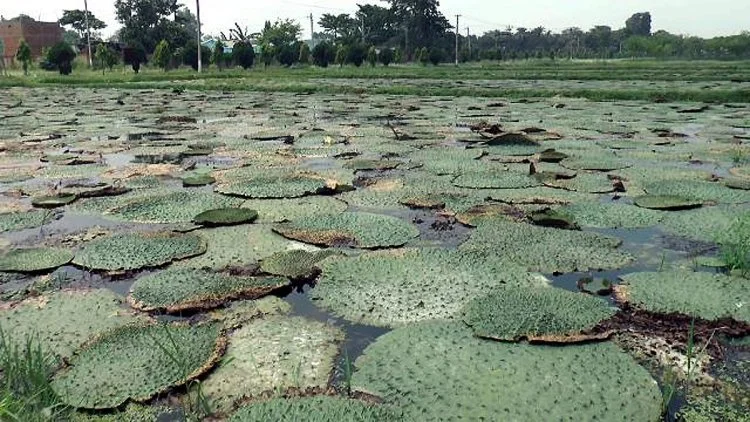History of Foxnut
Explore the captivating History of Foxnut and Foxnut Origin, a journey through time that highlights its roots, evolution and cultural significance, making history of makhana come alive.
Makhana, also known as foxnut or lotus seed, is a versatile and nutrient-rich food that has been cherished for centuries. Its makhana origin traces back to ancient civilizations, where it held significant cultural, medicinal, and culinary value. From the marshy ponds of Madhubani, a region in Bihar, emerges a valuable treasure that has been part of India’s culinary and nutritional heritage for centuries. This is Makhana, also known as fox nuts, Euryale ferox, lotus seeds, gorgon nuts, or phool makhana. These tiny, round, popped seeds are not just versatile in their culinary use, but are also packed with health benefits, earning them a revered place in traditional Indian medicine as well. The rich foxnut history highlights its long-standing significance in various cultures and its continued popularity in modern times.
Makhana is the popped and expanded kernel of the Fox nut or Gorgon nut. These nuts are harvested from water bodies and undergo a popping process to remove the edible starchy kernel. It has a rich history of makhana dating back to its cultivation in Madhubani, a popular Mithilanchal region of Bihar. This expanded kernel is what we know as Makhana in India. Fox Nuts history is rich, Makhana was traditionally cultivated by a community of poor farmers using age-old methods, and from there, it spread to other parts of the country.


History of Foxnut and Foxnut Origin
The cultivation of Makhana in India has a deep-rooted History of Foxnut, starting from the Mithilanchal region of Bihar. The Madhubani district of Bihar is renowned as the birthplace of Makhana cultivation. Here, a community of underprivileged farmers began the practice of cultivating Makhana, also known as Foxnut. The Foxnut Origin story involves using traditional methods. The cultivation process is labor-intensive, requiring the farmers to collect the nuts from water bodies, dry them, and then pop them to extract the edible kernel.
Over time, the popularity of Makhana began to spread across the country, and its seeds found their way to different regions. Foxnut Origin from the wetlands of Bihar, Foxnut, or Makhana, is known for its unique taste, versatility in cooking, and numerous health benefits, making it a popular choice in households across India. Today, Makhana is not just a local snack or ingredient but has gained international popularity as a superfood.
Foxnut Properties

Protein and Fiber Content
Makhanas are a rich source of protein, which is a crucial nutrient required for the repair and growth of body tissues. They also contain a good amount of dietary fiber, which aids digestion and helps in maintaining a healthy weight. The high protein and fiber content also make Makhana a satiating snack

Antioxidant Properties
One of the key health benefits of Makhana is its antioxidant properties. It contains an anti-ageing enzyme that helps in repairing damaged proteins. Antioxidants help in protecting the body against damage caused by free radicals, reducing the risk of chronic diseases like heart disease, cancer, and diabetes.

Essential Minerals
Makhana is also packed with several essential minerals such as calcium, iron, magnesium, and potassium. These minerals play a critical role in various bodily functions. For example, calcium is essential for bone health, iron is crucial for oxygen transportation in the body, magnesium supports nerve and muscle function.
Ancient Origins and Cultural Significance
Makhana history can be traced to the Neolithic age, around 2000 BC, in the Indian subcontinent, particularly in regions that are now part of modern-day India and China. The origin of makhana is believed to be in the floodplains of Bihar, India, where it has been cultivated for centuries. In ancient India, makhana, also known as foxnut, was considered sacred and was often used in religious rituals and ceremonies. The seeds, Foxnut Origin, were revered for their purity and were offered to deities in temples.
In Chinese culture, Makhana, also known as foxnut or lotus seed, has been an integral part of traditional medicine. Ancient Chinese texts, dating back to the Tang Dynasty (618-907 AD), document the use of Makhana for its health benefits. These texts, mentioning the makhana origin, describe how the seeds were believed to have properties that could cure ailments and promote longevity. They were used in various medicinal preparations to treat conditions such as diarrhea, kidney problems, and insomnia.
Cultivation and Processing Techniques
The cultivation of Makhana is a labor-intensive process that has remained largely unchanged over centuries. The seeds are harvested from the Euryale ferox plant, which thrives in the stagnant waters of wetlands, ponds, and marshes. The origin of Makhana can be traced back to Bihar, a state in northeastern India, which is the largest producer of Makhana in the world, contributing to about 90% of global production.
The Traditional method of Makhana cultivation involves several steps:
Collection: The ripe seeds, which come from the origin of makhana, are collected from the water bodies. This is usually done by hand, making it a time-consuming and labor-intensive task.
Cleaning:The collected seeds, originating from the makhana plant, are cleaned to remove any impurities..
Roasting: The seeds, origin of makhana, are then roasted at a high temperature. This process requires skill to ensure the seeds do not burn and are roasted evenly.
Popping: After roasting, the seeds are popped. This step transforms the hard seeds into the white, fluffy Makhana kernels that are consumed.
Sorting and Grading: The popped seeds are sorted and graded based on their size and quality.
These traditional methods have been passed down through generations, preserving the authenticity and quality of Makhana, including its origin of makhana and traditional cultivation practices.
The Rising Popularity of Makhana Worldwide
The popularity of Makhana has been soaring not just within India but across the globe. More and more countries are importing Makhana from India due to its unique taste and health benefits. Some of these countries include the United States, Canada, the United Kingdom, Australia, and various Middle Eastern and Southeast Asian countries.
Countries Importing Makhana from India
India’s export of Makhana has seen a significant increase in recent years, with various countries around the world recognizing its nutritional value and culinary versatility. Let’s take a look at some of the countries that import Makhana from India.

United States
The United States has seen a rise in the demand for Makhana, primarily due to the growing awareness of healthy eating habits among its population. People in the US are switching to healthier snack options

Canada
Canada, too, has been importing Makhana from India in considerable quantities. The Canadian population has embraced this nutritious snack, incorporating it into their diet in various forms, from savories to desserts.

United Kingdom
The United Kingdom also features on the list of countries importing Makhana from India. With a significant Indian diaspora and growing interest in exploring global cuisines, Makhana has found its place in several households in the UK.

Australia
In Australia, the demand for Makhana has been driven by the increasing health consciousness among Australians. The versatility of Makhana, which can be used as a snack or an ingredient in various dishes, has also contributed to its popularity in Australia.

Middle Eastern and Southeast Asian Countries
Several Middle Eastern and Southeast Asian countries have also started importing Makhana from India. These regions have a rich culinary culture, and Makhana, with its unique taste and texture.

Germany
Germany have also started importing Makhana from India. These regions have a rich culinary culture, and Makhana, with its unique taste and texture, has added a new dimension to their cuisine. its high nutritional value and low calorie content.
Makhana in Ancient Texts and Mythology
Makhana, also known as Foxnut, finds mention in several ancient texts and mythological stories, highlighting its significance in ancient cultures. The History of Foxnut reveals its association with Lord Vishnu in Hindu mythology, where it is often mentioned in various religious scriptures and texts. It is believed that offering Makhana to Lord Vishnu brings prosperity and happiness.
In Ayurveda, the traditional Indian system of medicine, Makhana, also known as foxnut, is considered a ‘superfood’ with numerous health benefits. The history of foxnut shows that ancient Ayurvedic texts describe Makhana as having ‘balya’ (strengthening) and ‘rasayana’ (rejuvenating) properties. It is recommended for improving digestion, enhancing vitality, and balancing the ‘vata’ and ‘pitta’ doshas.
Makhana in Medieval and Colonial India
During the medieval period, Makhana, also known as foxnut, continued to be an important food source in India. Foxnut History shows that it was particularly popular among the royalty and aristocracy, who appreciated its unique taste and health benefits. Foxnut was often used in royal kitchens to prepare delicacies and special dishes for kings and queens.
With the advent of colonial rule in India, Makhana’s popularity spread beyond the Indian subcontinent. British colonialists took an interest in the unique crop, its potential as a commercial commodity, and the rich history of foxnut cultivation. During this period, efforts were made to document the cultivation practices and nutritional value of Makhana, also known as foxnut. The British introduced modern techniques to improve yield and quality, paving the way for its commercial production. The foxnut history has shown its importance and evolution in agriculture.
Makhana in Modern Times
In contemporary times, Makhana, known for its makhana origin in India, has gained global recognition as a health food. Its nutritional profile, rich in protein, fibre, and essential minerals, has made it a popular choice among health enthusiasts and nutritionists worldwide. Makhana is often recommended as a healthy snack for weight management, heart health, and overall well-being.
In India, Makhana, which has its roots in ancient traditions, continues to be an integral part of the culinary tradition. It is used in a variety of dishes, from savory snacks like roasted Makhana to sweet preparations like Makhana kheer (a milk-based dessert). The versatility of Makhana, with its rich makhana origin, makes it a favorite ingredient in both traditional and modern recipes.
The increasing demand for healthy and natural foods has led to a resurgence in Makhana’s popularity, also known as fox nuts. This snack is now available in various forms, including flavoured and packaged options, making it convenient to enjoy. The global market for Makhana is expanding, with countries like the United States, Canada, and the United Kingdom importing significant quantities. Makhana, or fox nuts origin, comes from the seeds of the Euryale Fox plant, which grows in water bodies.
Challenges and Future Prospects
Despite its numerous benefits, the cultivation of Makhana faces several challenges. The traditional methods of harvesting and processing, rooted in Makhana history, are labor-intensive and time-consuming, making it difficult to meet the growing demand. Additionally, the farmers engaged in Makhana cultivation often lack access to modern tools and techniques, impacting their productivity and profitability.
However, with increasing awareness and support from the government and agricultural organizations, efforts are being made to modernize Makhana cultivation. Research is being conducted to develop high-yielding varieties and improve processing techniques. Training programs and workshops are being organized to educate farmers about sustainable practices and efficient methods. Understanding the history of Makhana also plays a crucial role in these efforts, helping to preserve traditional knowledge while integrating modern advancements
The future of Makhana looks promising, with growing interest from the global market and the potential for value-added products. Innovations in packaging and marketing are helping to position Makhana history, which has a rich use in traditional medicine and cuisine, as a premium health food. This is attracting consumers from different parts of the world.
The Rising Popularity of Makhana Worldwide
The popularity of Makhana, which has a rich history, has been soaring not just within India but across the globe. More and more countries are importing Makhana from India due to its unique taste and health benefits. Some of these countries include the United States, Canada, the United Kingdom, Australia, and various Middle Eastern and Southeast Asian countries.
Reasons for the Increasing Demand for Makhana
The increasing demand for Makhana worldwide can primarily be attributed to two factors: growing awareness of healthy snacking habits and interest in exploring global cuisines. As people become more health-conscious, they are looking for nutritious and satisfying snacks like Makhana. Additionally, with the world becoming a global village, people are more open to trying out new foods from different cultures. Makhana history fits right into this trend.
Growing Awareness of Healthy Snacking Habits
One of the primary reasons behind the rising popularity of Makhana is the growing awareness about healthy snacking habits. With lifestyle diseases on the rise, people are now more conscious about what they eat. They are increasingly opting for nutrient-dense snacks like Makhana, which not only satiate their hunger pangs but also provide them with essential nutrients. Additionally, the origin of Makhana, known for its traditional use in Indian diets, adds to its appeal as a wholesome snack choice.
Interest in Exploring Global Cuisines
The globalisation of culinary culture has also played a significant role in promoting Makhana to an international audience. With the advent of global media and the internet, people are becoming more adventurous with their food choices. They are eager to explore different cuisines from around the world. The unique texture and taste of Makhana, coupled with its versatility in cooking, has piqued the interest of food enthusiasts worldwide. Whether it’s Indian sweets like Kheer or savoury dishes like Makhana curry, this superfood has found its way into various global recipes.
Ways to Enjoy Makhana
Makhana, also known as fox nuts, is one of those versatile ingredients that can be used in a variety of ways. From traditional Indian sweets and savouries to modern snacks and desserts, there are numerous ways to enjoy this healthy and tasty seed. The origin of fox nuts can be traced back to ancient times, adding to their rich culinary heritage.
Using Makhana in Indian Sweets and Savouries
In India, Makhana is commonly used in a variety of sweet and savoury dishes. It is used in making kheer, a popular Indian dessert made with milk, sugar, and various dry fruits. Makhana adds a unique texture to the kheer, making it an instant hit during festive seasons. Apart from kheer, it is also used in making raita and Makhana curry. These dishes showcase the versatility of Makhana, which can be used in both sweet and savoury recipes.
Roasting Makhana as a Snack
Makhana makes for a perfect snack when roasted. Roasted Makhana is light, crunchy, and can be flavoured with a variety of spices. You can roast Makhana with a little bit of ghee or oil and then add your choice of spices. This makes for a healthy and satisfying tea-time snack, which is not only delicious but also packed with nutrients.
Incorporating Makhana into Desserts and Ice Creams
Given its subtle flavour and pleasing texture, Makhana, also known as fox nuts, can be used in making desserts and ice creams. It can be ground into a powder and used as a base for various desserts. Makhana ice cream is another innovative way to incorporate this superfood into your diet. The light and airy texture of Makhana adds a unique twist to the creamy and smooth consistency of ice cream. Fox nuts origin is fascinating and is known for its health benefits and versatility in different dishes.
Makhana, the humble popped seed from the marshy ponds of Bihar, has indeed made a global mark. Its journey from being a traditional Indian ingredient to becoming a popular superfood worldwide is truly remarkable.
The Global Journey of Makhana
While Makhana, also known as fox nuts, continues to be a staple in many Indian households, its popularity has now crossed borders, reaching homes in the United States, Canada, the United Kingdom, Australia, and even Middle Eastern and Southeast Asian countries. This growing demand is a testament to Makhana’s nutritional value and culinary versatility. It serves as an example of how food can bridge cultural gaps, promoting a shared appreciation for diverse culinary traditions and healthful eating. The origin of fox nuts, with their unique history and benefits, is gaining recognition worldwide.
Whether you enjoy it as a crunchy snack, use it in your favorite Indian sweets and savories, or experiment with it in your desserts, Makhana (fox nuts) offers a multitude of ways to be incorporated into your diet. So, the next time you’re looking for a healthy yet tasty snack option or an interesting ingredient to try in your cooking, remember the Makhana – Bihar’s valuable treasure that has taken the world by storm.